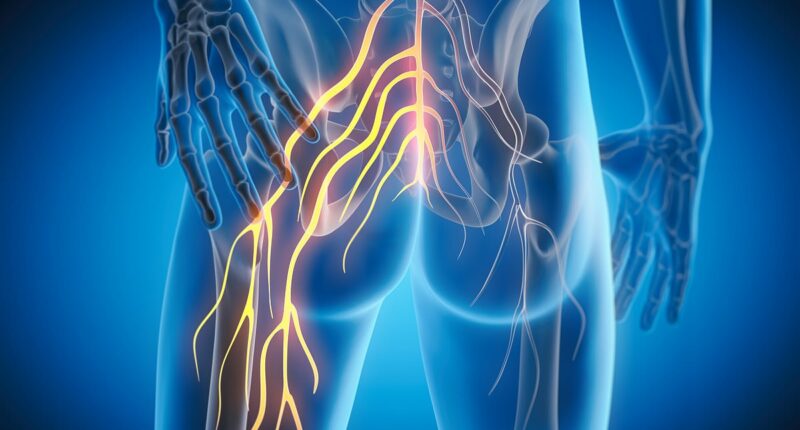Share this @internewscast.com
The day before she was set to fly to Cape Town for her grandson’s wedding, Shirley Boyle was hit with what she calls ‘the worst back pain of my life’.
Determined to not miss the event, the 77-year-old former dental practice manager from Newcastle-under-Lyme endured the almost 12-hour flight. However, upon landing in South Africa, she found herself using crutches, with painkillers hardly alleviating her discomfort. It was evident this was more than just a simple pulled muscle. Shortly after returning home, her doctor diagnosed her with sciatica.
This condition arises when the roots of the sciatic nerve – which extends from the lower back through the hips and legs – become irritated or compressed. It is quite common, affecting about three million people in Britain each year, and as many as four out of ten individuals at some point in their lives.
While in most situations it resolves on its own within a few months, the pain during this period can be intense – and, for some sufferers, entirely incapacitating.
NHS guidelines suggest a gradual approach to treating sciatica, starting with over-the-counter pain relief, progressing to mild opioids, nerve-related pain medication like gabapentin, and, in certain instances, epidural injections.
In the most severe cases, patients may even undergo surgery to decompress the nerve.
However, experts informed The Mail on Sunday that the vast majority of sufferers can alleviate – and sometimes even eliminate – the condition on their own, without resorting to strong medications, by adopting a few lifestyle adjustments.
As columnist Dr Ellie Cannon wrote last week, although she sees patients with sciatica ‘almost every day’, many remain unaware of the simple treatments available. She asked readers to share how they had managed their often-debilitating sciatica – and was inundated with letters and emails.

Sciatica occurs when the roots of the sciatic nerve – which runs from the lower back down through the hips and legs – become inflamed or compressed
Their suggestions ranged from the conventional – physiotherapy, regular exercise and weight loss – to the more unusual, including inversion tables to create space between the vertebrae; CBD patches on the area and even regular buttock massages.
One woman even wrote that she cured her sciatica by ditching her underwired bras: ‘I’ve swapped to highly unflattering shapewear that is like a surgical stocking and gives no shape whatsoever. But I have not worn a bra in six months and have not had sciatica since,’ she added.
For Shirley, the solution was similarly surprising: acupuncture.
‘I’d tried it before for hip pain, so I booked a session as soon as I got home,’ she said. ‘After the first treatment I felt nothing – I thought it was a waste of money. But later that day, after sitting in my armchair for a few hours, I stood up and walked to the kitchen without my crutches.
‘By the seventh session the pain had gone completely – and it’s never come back. It’s amazing.’
So what actually works for sciatica – and what’s just a gimmick? We asked the experts…
SWIMMING BEATS REST
IT might sound counterintuitive, but one of the best remedies for a trapped sciatic nerve is regular movement and staying active.

Swimming is one of the best forms of exercise to ease back pain, including sciatica
‘Two or three decades ago people were told to rest in bed,’ says Dr Annina Schmid, professor of pain neurosciences at Oxford University. ‘But we now know staying active is the most important thing for recovery.’
Research shows repeated light exercise eases most types of back pain – including sciatica – and NHS guidelines recommend keeping mobile.
One of the best forms, experts say, is swimming.
The water’s buoyancy reduces stress on the spine, while its
resistance strengthens core and back muscles. This low-impact exercise also boosts circulation and lowers inflammation.
‘Animal studies show swimming is incredibly effective at healing sciatic nerve injuries,’ says Dr Schmid. ‘Aerobic exercise improves nerve pain and has a regenerative effect, helping nerves heal and grow back properly. It also has a potent anti-inflammatory effect – as effective as some medication.’
FIND RELIEF ON THE MAT
Like swimming, yoga can also help soothe sciatica. For Fife-based gardener Stewart Moreland, 70, it was the cure for decades of agony.
‘I first got sciatica in my 30s from too much time in the gym,’ he said. ‘I trapped a nerve and from then I was in constant pain. I tried everything – nothing worked. It became so bad I couldn’t sleep.’
Relief only came when a friend suggested yoga. Stewart began a gentle back-strengthening routine every morning.
‘I found a sequence online and stuck with it,’ he said. ‘Within two weeks the pain eased, and eventually it disappeared.
‘I’ve had no sciatica since – that was nearly 20 years ago.’
Research backs him up. A University of Southampton trial in 2015 found patients with lower back pain and sciatica who did yoga for three and six months had
significantly less pain and disability than those given standard medical care.
A 2005 University of Washington study also reported ‘superior’ improvements in back function among those who practised yoga regularly. The benefits lasted for several months at least.
But not all yoga is suitable, warns Dr Colette Ridehalgh, physiotherapist and lecturer at King’s College London. ‘There are so many different types and techniques, and it’s about being sensible about what you can and can’t do,’ she said.
‘Prolonged or forceful movements may aggravate pain in the early stages, so monitor which positions do or don’t work for you.
‘Make sure you go to a yoga teacher with reasonable qualifications and tell them that you’re having leg and back pain before you begin the class so that they can advise you.’
And as with all forms of exercise, say both Prof Schmid and Dr Ridehalgh, don’t push it.
‘See what works best for you – not all forms of exercise will suit everyone,’ said Dr Ridehalgh.
‘Pay attention to how you’re feeling when you’re doing it, and if you’re still experiencing prolonged symptoms after, then you may be doing too much.’
FIND AN ALTERNATIVE
Less traditional approaches such as acupuncture and chiropractic have less evidence behind them – but some patients swear by them.
Although NHS guidelines don’t recommend acupuncture for sciatica, Dr Ridehalgh says there’s no reason it can’t be tried. The ancient Chinese therapy uses fine needles thought to trigger natural pain-relieving chemicals, improve circulation and ease stiffness.
Research is mixed, but one Chinese trial found sciatica patients who had acupuncture for a month reported less leg pain and better function lasting up to a year. ‘We think it works by stimulating sensory nerve fibres, which trigger a pain-relieving effect in the brain,’ says Dr Ridehalgh.

Acupuncture, although not recommended by the NHS for sciatica, has helped some sufferers
‘Whatever the mechanism, if it helps reduce pain that’s positive – though it won’t speed up healing.’
Hands-on therapies such as chiropractic or osteopathy can also provide short-term relief, says Oxford University’s Professor Annina Schmid.
‘Adjustments may reduce how many pain signals the nervous system sends,’ she explained.
‘It’s a bit like distraction – it inhibits the sensation temporarily. But the effect tends to wear off within 24 hours.’
For some, though, it works. Angela Godwin, 81, from Kent, found that chiropractic treatment was the only thing that helped her sciatica pain.
‘I tried physiotherapy and anti-inflammatory medication, belladonna plasters [adhesive patches] and all sorts of other things,’ she said. ‘They helped, but didn’t get rid of the pain.’
‘Then, a friend told me to try a chiropractor, and within six treatments, I was free of pain. If I ever got another bout of sciatica, I had more sessions with my chiropractor, and now am completely cured – I haven’t needed any further treatment for over a year.’
Just make sure any manual therapy, or acupuncture, is used in conjunction with exercise, advises Dr Ridehalgh.
SIT UP STRAIGHT
As many as 80 per cent of Britons will suffer lower back pain at some point, and about five per cent live with it as a chronic condition – often linked to sedentary lifestyles and poor posture.
Spending hour upon hour hunching over a desk was the cause of nurse and senior lecturer Marie Gressman’s pain [see box, left].
And experts say poor posture is a common trigger for sciatica flare-ups, putting excessive strain on the lower back.
Professor Schmid explains: ‘It’s very important people understand what sciatica is, to help them understand how things they do might relieve or trigger it.’
The sciatic nerve is most often irritated or compressed by a slipped disc or narrowing of the spinal canal (spinal stenosis). Strengthening the back and core muscles helps prevent both.
The NHS recommends gentle stretches, such as raising the knees to the chest one by one while lying flat and holding it there for a few seconds, or lifting the hips into the air from the same position.
Simply maintaining good posture while sitting, standing or even lying down can also ward off flare-ups. For Marie, a small roll fixed to her office chair to support her lower back, along with daily core exercises, eventually eased her pain.
Even sleep position can make a difference, says Prof Schmid.
For some, laying in bed for prolonged periods can cause back pain and nerve compression. Changing position can help decompress the spine by increasing the space between the vertebrae. ‘Those who find stomach-sleeping painful can place a pillow under the abdomen,’ said Prof Schmid. ‘Side-sleepers may benefit from a pillow between the knees. Physios can help identify the best positions, though it often takes trial and error – the body usually tells you what does and doesn’t help.’
AVOID GADGETS
The internet is awash with supposedly sciatica-relieving gadgets – but most won’t help, warns Professor Annina Schmid.
‘There are plenty of machines claiming to use electrical pulses to ease pain – but studies show they don’t help sciatica,’ she said.
Corsets and belts are another false promise. While lumbosacral corsets can aid recovery from spinal fractures or surgery – acting like a temporary cast by limiting movement – they do nothing for sciatica. Prolonged use can even weaken the core by letting muscles waste away.
‘It’s much cheaper to put a hot pack on your back,’ said Prof Schmid. ‘There’s no evidence it works either – but at least it won’t cost you anything.’
Instead, experts say the real key is movement. ‘A lot of people with sciatica stop being active, but the sooner you resume everyday activities, the better the recovery,’ said Dr Colette Ridehalgh. ‘If you still struggle after a few weeks, speak to your GP about other support.
‘But with the right management most people do fully recover – it just takes time and effort.’

















